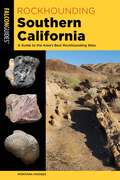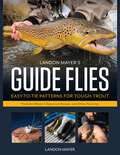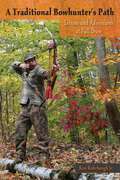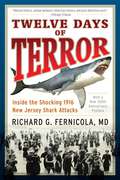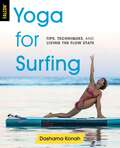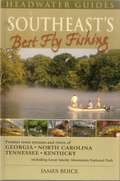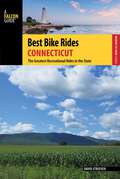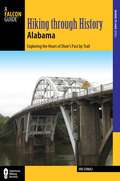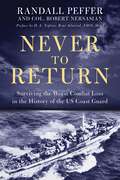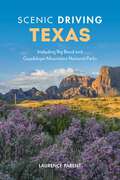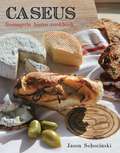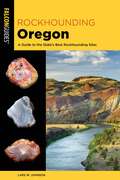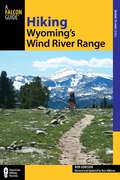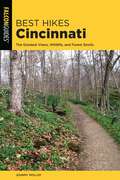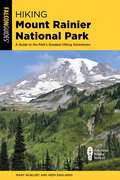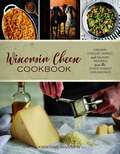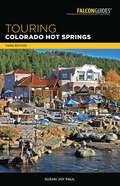- Table View
- List View
Hiking New Jersey: A Guide to the State's Greatest Hiking Adventures
by Johnny MolloyNew Jersey&’s stereotype as overpopulated and industrial notwithstanding, there&’s another New Jersey worth seeing—and this guide goes there. This is the aptly nicknamed Garden State of preserved forests and farmland, of streams and waterfalls, of clean beaches and vast wetlands, of endless green mountains. This comprehensive, informative, user-friendly guide describes fifty hikes for all abilities.
Rockhounding Southern California: A Guide to the Area's Best Rockhounding Sites (Rockhounding Series)
by Montana HodgesAlthough known for its gold production, California is a virtual haven for rock and gem collectors. With Rockhounding Southern California, you can explore the mineral-rich desert regions, comb tide-washed beaches for jade, agate, abalone, fossilized whale bone, and prospect in the mountains and hills for gold, copper, and other minerals and gems. It describes the state's best rockhounding sites and covers popular and commercial sites as well as numerous little-known areas. This handy guide also describes how to collect specimens, includes maps, directions, and GPS coordinates for each site, and lists rockhound clubs around the state. Rockhounding Southern California offers a complete introduction to this many-faceted hobby.
Landon Mayer's Guide Flies: Easy-to-Tie Patterns for Tough Trout
by Landon MayerWhen you spend as much time on the water as guide Landon Mayer, you need simple, easy-to-tie patterns that get the job done, day in and day out. In this fly-tying book, Mayer shares 20 of his top patterns for trophy trout that have been perfected on rivers and still waters in the Rockies and across the globe. These flies include twelve of Mayer&’s own designs as well as eight of his favorite flies by, Arlo Townsend, Angus Drummond, Phil Tereyla, Walt Mueller, Jr., Michael Burgess, Dave Hoover, Kevan Davidson, and Ken Walwrath. Instructions for each fly are covered in over 200 detailed step-by-step photos, each chapter includes fishing and rigging tips, and the book includes seven rigging illustrations by Dave Hall. Patterns in this book include the Tails Up Trico, Mayer&’s Mini Leech, Titan Tube Midge, Mini Leech Jig Damsel, and many more.
A Traditional Bowhunter's Path: Lessons and Adventures at Full Draw
by Ron RohrbaughThis guide to traditional bowhunting with a longbow or recurve combines the best of both worlds for beginners and veteran bowhunters. How-to chapters share hard-earned wisdom that will help you perfect your skills and get close to your game, while engaging stories tell of the author&’s experiences hunting white-tailed deer in the east, chasing big game in the American West, and trekking to South Africa in search of Greater Kudu and other plains game. Throughout, the author highlights archery&’s traditional spirit by exploring the history and craft of bowhunting and chronicles the challenges faced by today&’s bowhunters in continuing their important role as hunter-conservationists.As a professional wildlife biologist, Ron Rohrbaugh Jr. also provides valuable information on wildlife ecology and behavior that is instructive for all those interested in increasing their success with archery tackle.Specific shooting techniques for hunting situations, ways to set up effective ambush sites for big game, and dealing with the stresses of &“buck fever&”The latest information on equipment and arrows, including the pros and cons of various bow styles and arrow shaft materialsAdvice on using the wind, hunting bedding areas, creating effective scent trails, and understanding why and how deer moveDiscussion of controversial topics, such as baiting and trophy hunting
Twelve Days of Terror: Inside the Shocking 1916 New Jersey Shark Attacks
by Richard G. FernicolaUpon the 100th anniversary of the most terrifying stretch of shark attacks in American history--a wave said to have been the inspiration for Jaws--comes a reissue of the classic Lyons Press account and investigation. In July 1916, a time when World War I loomed over America and New York City was in the midst of a deadly polio epidemic, the tri-state area sought relief at the Jersey shore. The Atlantic&’s refreshing waters proved to be utterly inhospitable, however. In just twelve days, four swimmers were violently and fatally mauled in separate shark attacks, and a fifth swimmer escaped an attack within inches of his life. In this thoroughly researched account, Dr. Richard Fernicola, the leading expert on the attacks, presents a riveting portrait, investigation, and scientific analysis of the terrifying days against the colorful backdrop of America in 1916 in Twelve Days of Terror.
Yoga for Surfing: Tips, Techniques, and Living the Flow State
by Dashama KonahStrengthen and Balance Your Body and Soul for Health, Happiness, and LongevityYoga for Surfing guides you through over 100 yoga and meditation practices that effectively teach the reader how to access the flow state of consciousness for greater health, happiness, creativity, success, and life fulfillment. Fully illustrated with photos and clear, concise instructions that demonstrate how to do yoga in a variety of settings—on the beach, on the board, while floating on water, with or without props—there is something here for everyone to benefit from, whether they are advanced surfers or beginners.Notable contributors include:Shiva Rea Donica Shouse Jeremie VainePeggy Hall Zane Kekoa Schweitzer Noelani LoveEoin Finn Kendyl Beschen Jessi MoonWith helpful advice on surfing techniques, performance focus, and relaxation, as well as inspiring short stories about surfers who have healed themselves via yoga, this is the ultimate guide to mind/body wellness in and out of the water.
Southeast's Best Fly Fishing
by James BuiceNew series of fly fishing guides covering only the best waters, written by local experts Detailed maps created with latest GIS mapping software--more accurate than any previous fly-fishing guidebook maps; it covers trout streams and rivers of Georgia, North Carolina, Tennessee, and Kentucky Includes Great Smoky Mountains National Park, the nation's most popular national park with more than 9 million visitors per year Whether you are flying through Atlanta on business (the Chattahoochee River provides superb fishing just outside of city limits) or taking an extended trip into the backcountry of Great Smoky Mountains National Park, this guide gives you the information you need for a successful fishing trip. With stunning photos, detailed hatch charts for each river, photos and recipes of the most effective fly patterns, and insider information from local guides and outfitters, this book is an essential reference for the south's best trout fishing.
Best Bike Rides Connecticut: The Greatest Recreational Rides in the State (Best Bike Rides Series)
by David StreeverBest Bike Rides Connecticut describes 40 of the greatest recreational rides in the Connectiut. Road rides, rail rides, bike paths, and single-track mountain bike rides all get included. Most rides are in the 5- to 35-mile range, allowing for great afternoon outings and family adventures (though there are plenty of challenging rides in the mix as well). Best Bike Rides Connecticut includes a map of each ride, a log of significant mile points, a text description of the ride, a start-finish point with nearby motor vehicle parking, the GPS coordinates of the start-finish point, and color photos of one of the ride's features. Also included is information on local restaurants, lodging, maps, bicycle shops, other facilities for cyclists, and community resources.
Basic Home Repair & Maintenance: An Illustrated Problem Solver (Knack: Make It Easy)
by Terry MeanyDon't panic at the prospect of home repair and maintenance! With this informative and well-organized guide you'll have the knowledge and instruction you need to deal with or prevent scores of the most common problems in your home. Its 460 full-color photographs and step-by-step instructions show you how things work, what can go wrong, and whether there is a quick fix. You'll know when to call repair service and when you can do the work yourself. From painting to electrical work, plumbing, and maintenance, this book makes home repair and maintenance projects easy, providing clear, commonsense ways to save time and money. Topics covered include:Guidance on assessing the problem Essential information on tools, supplies and techniques every homeowner should have How to Paint Fixing scratches, squeaks, scrapes and chips Repairing leaks and clogs Electrical repairs you can do Dealing with mold, mildew, moss and dry rot Yard work Running an energy efficient homeAn extensive resource guide to products and Web sources is provided as well.
Hiking Through History Alabama: Exploring the Heart of Dixie's Past by Trail from the Selma Historic Walk to the Confederate Memorial Park (Hiking Through History)
by Joe CuhajWhether you're a curious tourist or a local history buff, this guidebook contains all the tools you'll need to explore the Heart of Dixie's history. From ruins to battlefields, each of the 40 featured hikes comes with helpful maps and directions, as well as a carefully researched impression of the trail, and a comprehensive guide to the area's natural and human history.
Foraging the Ozarks: Finding, Identifying, and Preparing Edible Wild Foods in the Ozarks
by Bo BrownThe Ozark Mountains in Missouri and Arkansas have had a long history of foraging since indigenous tribes such as the Osage, Quapaw, and Kickapoo sporadically inhabited the area and utilized the rich natural resources. Settlers from the Appalachians came later and survived on what they could find, trap, and hunt. Foraging remains a major activity among the Ozarks&’ outdoor community, supported in large part by established local restaurateurs and other buyers of wild herbs, berries, and nuts.Foraging the Ozarks, written by local wilderness expert Bo Brown, highlights about a hundred commonly found edibles in the Interior Highlands, from ubiquitous herbs to endemic species. With sidebars, recipes, helpful tips, and toxin warnings throughout, Foraging the Ozarks is the only guidebook the Ozark outdoor enthusiast will need to pick it, cook it, and eat it.
Hiking Montana's Bob Marshall Wilderness
by Erik MolvarDiscover the trails located with the glorious 1.5 million acres of the Bob Marshall Wilderness located in Northwestern Montana. From rugged ridge tops to gently sloping meadows this updated and comprehensive guide contains detailed maps and trail descriptions that leads hikers of all levels through the expansive region.
Never to Return
by Randall Peffer Robert NersasianNever to Return is the harrowing tale of the torpedoing and sinking of a Coast Guard ship and the loss of 171 Coast Guardsmen off the coast of Iceland during WWII.TheUSS Leopold was a U.S. Coast Guard destroyer escort in a convoy of merchant ships carrying war materiel to England, on the lookout for the deadly U-boat wolf packs lurking in the North Atlantic. The Leopold was largely unarmored, lightly armed, and no match for the U-255&’s torpedoes. Never to Return is the story of gunner Sparky Nersasian and his shipmates&’ struggles to survive the Leopold&’s sinking.
Come on Over Cookbook
by Gooseberry PatchWhen asked what guests can bring, you can feel good replying "just bring yourselves!" Updated with 22 photos, this best-seller, originally published in 2004, is filled with tried & true recipes, effortless decorating how-to&’s, handy timesaving tips and great ideas for memorable gatherings.You&’re invited! Come as you are…we&’ve made it so easy for you to make simple meals special and special meals simple! Invite neighbors over for a morning brunch with Yummy Caramel French Toast and a Baked Garden Omelet or jazz up an ordinary cookout with Fabulous Baked Potato Casserole, Snappy Asparagus Dip and Strawberry-Banana Sherbet. Celebrate a special occasion with Country Club Salad, Classic Lasagna and Peaches & Cream Pie. An appetizer party is so easy with recipes like Crab-Stuffed Mushrooms, Honey-Glazed Chicken Wings and Mini Manicotti. Treat family & friends to Pumpkin Chowder, Elegant Chicken Roll-Ups and Mocha Brownie Cookies during a holiday get-together this year. We&’ve also included fun ideas for bringing family & friends together more often along with tips for turning everyday dishes into crowd-pleasing delights. When it comes to setting the table, you&’ll just love our clever decorating ideas that leave big impressions. So stay in tonight and invite a few friends over…it&’s never been easier! 248 Recipes.
Scenic Driving Texas: Including Big Bend and Guadalupe Mountains National Parks (Scenic Driving)
by Laurence ParentDiscover the Lone Star State with over 30 recommended drives. Scenic Driving Texas provides indispensable information, including directions and a map for each itinerary, in-depth descriptions of attractions and points of interest, travel tips, and more. In addition to the text being fully revised and updated, the fourth edition features stunning new color photos.
Caseus Fromagerie Bistro Cookbook: Every Cheese Has a Story
by Jason SobocinskiIn addition to more than 150 recipes this title includes explanations of gourmet jargon, where to find unique ingredients, as well as suggestions on substitutions (considering both price and availability).
Gardening in the South: Vegetables & Fruits
by Donald M. HastingsThis second volume in the Gardening in the South series gives readers a complete course in growing fruits and vegetables.
Rockhounding Oregon: A Guide to the State's Best Rockhounding Sites (Rockhounding Series)
by Lars W. JohnsonFully revised and updated, this book provides detailed directions and GPS coordinates to the best rockhounding sites in Oregon, with valuable tips on what tools to bring and how to conduct your search. Comprehensive lists of minerals or fossils for each site and excellent color photos will help you know what to look for and to identify what you&’ve found. Information on clubs, rock shops, museums, and special attractions are provided. Rockhounding Oregon is a must-have for anyone interested in collecting their own minerals, gems, and fossils in the region.
Hiking Wyoming's Wind River Range (Regional Hiking Series)
by Ron Adkison Ben AdkisonCovering nearly all of the wilderness trails in the Wind River Range and offering suggestions for day hikes, extended trips, and off-trail exploration, this book contains detailed descriptions and maps to get you to the trailheads and help you plan your trip. This new edition includes new full color maps and stunning full color photos, as well as GPS coordinates for all trailheads. Look inside to find:• Hikes suited to every ability• Mile-by-mile directional cues• Difficulty ratings, trail contacts, fees/permits, and best hiking seasons • An index of hikes by category, such as easy day hikes, extended backcountry trips, hikes to lakes, and hikes for solitude • Invaluable trip-planning information, including local lodging and campgrounds• Full-color photos throughout
21 Crocheted Tanks + Tunics: Stylish Designs for Every Occasion
by Sandi RosnerCrochet yourself cool with fashionable sleeveless tops that will fit your style! Crocheted fashion isn't just for cold weather with the 21 refreshing designs in this book, perfect on their own or as layers.
Best Hikes Cincinnati: The Greatest Views, Wildlife, and Forest Strolls
by Johnny MolloyWho says you have to travel far from home to go on a great hike? In Best Hikes Cincinnati veteran hiker Johnny Molloy offers the absolute best hikes in the greater Cincinnati area. Each featured trail is perfect for the urban and suburbanite hard-pressed to find outdoor activities close to home. This guide leads you through forests, over streams, and along lakeshores to the best outdoor adventures around Cincinnati: Take in gorgeous views on the Old Sugar Camp Hike.Experience nature&’s beauty in the Loops of Miami Whitewater Forest.Bring your dog on an exciting trek along the Whitewater Canal Historic Trail.Every chapter includes up-to-date hike specs, a brief hike description, directional cues, and a detailed map.
Hiking Mount Rainier National Park: A Guide to the Park's Greatest Hiking Adventures
by Mary Skjelset Heidi RadlinskiFully updated and revised, the fifth edition of Hiking Mount RainierNational Park is a comprehensive and concise guide to the well-maintained trails of the diverse landscape nestled between the two major metropolises of the Pacific Northwest. Included are sixty hike descriptions for hikers of all ages and skill levels.
American Lighthouses: A Comprehensive Guide to Exploring Our National Coastal Treasures (Lighthouse Series)
by Ray Jones Bruce Roberts Cheryl Shelton-RobertsA celebration of the great American lighthouses, their keepers, their histories, and their ongoing storiesFor more than two centuries, lighthouses have helped sailors find their way through treacherous waters, guiding them home or taking them safely through passages on their way to adventure. These historic towers and houses form a sparkling chain of lights along our coasts, a reminder of the past echoing with adventure and mystery, a lure for travelers looking for a glimpse into a romantic past. Completely revised and updated, American Lighthouses offers more than just a tour of 450 beautiful and historic navigational beacons dotting the coasts and lakes of the United States. This fully illustrated, one-of-a-kind handbook details their history and architecture and provides full information on visiting or viewing them. Included are many endangered lights, threatened by erosion or lack of funding, as well as &“ghost lights,&” which are no longer standing.
Wisconsin Cheese Cookbook: Creamy, Cheesy, Sweet, and Savory Recipes from the State's Best Creameries
by Kristine HansenGrating, Slicing, Baking and Sprinkling Wisconsin&’s Best Cheeses. Wisconsin&’s artisan cheese scene is steeped in tradition and bursting with innovations. Local cheesemakers attract visitors from all over the world. Cheese is a huge part of the state&’s tourist draw and homegrown character. Everyone who calls Wisconsin home or visits for a day will love this book of the best recipes to cook with cheese. Stunning photos and 60 recipes from the 28 creameries featured will include comfort-food staples like pizza, mac &‘n cheese and grilled-cheese sandwiches, as well as wow-worthy dinner-party favorites such as mascarpone cheesecake, plus picnic-friendly salads and delicious breakfasts.Noteworthy creameries covered include Carr Valley Cheese and Emmi Roth in Southwest Wisconsin; BelGioioso Cheese and Sartori in Northeast Wisconsin; Holland&’s Family Cheese in Northwest Wisconsin; and Clock Shadow Creamery in Southeast Wisconsin.
Touring Colorado Hot Springs (Touring Hot Springs)
by Susan Joy PaulThere is not a more serendipitous surrounding to soak in than the Rocky Mountains of Colorado. Touring Colorado Hot Springs provides detailed descriptions, easy-to-read maps, and firsthand information on the best hot springs in the state. Descriptions are spiced with historical information and hot springs trivia that gives insight into the area's past. This entertaining and informative new edition will lead you to world-class family resorts and lesser known hidden springs in Colorado. It includes fully updated and revised text, new photos, GPS coordinates of all the hot springs, information on wheelchair access, and suggestions for accommodations.

